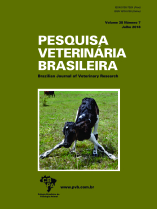 |
|
|
|
Year 2018 - Volume 38, Number 7
|

|
Differential diagnosis of neurologic diseases of cattle in the state of Paraná, 38(7):1264-1277
|
ABSTRACT.- Queiroz G.R., Oliveira R.A.M., Flaiban K.K.M.C., Di Santis G.W., Bracarense A.P.F.R.L., Headley S.A., Alfieri A.A. & Lisbôa J.A.N. 2018. [Differential diagnosis of neurologic diseases of cattle in the state of Paraná.] Diagnóstico diferencial das doenças neurológicas dos bovinos no estado do Paraná. Pesquisa Veterinária Brasileira 38(7):1264-1277. Departamento de Clínicas Veterinárias, Centro de Ciências Agrárias, Universidade Estadual de Londrina, Campus Universitário, Cx. Postal 6001, Londrina, PR 86051-990, Brazil. E-mail: janlisboa@uel.br
The aim of this study was to identify the neurological diseases that affected cattle in Paraná state between the years 2009 and 2015. The investigation took place, preferably, in the farms where cases occurred. Information on the evolution of the diseases in the affected cattle of the herd was recorded, and the probable risk factors were identified. All general and neurological examination procedures were performed systematically for the characterization of the neurological syndrome in each case. Samples of blood and CSF for laboratory exams were also collected. According to the evolution features and the severity of the observed clinical signs, the diseased cattle were kept alive to follow the progress of the disease, or were submitted to euthanasia followed by necropsy. Fragments of tissues from nervous system and other organs were collected for histopathological examination. Direct immunofluorescence test and biological test were performed on all the cattle that died, in order to confirm or rule out the diagnosis of rabies. Specific virology, bacteriology and toxicology laboratory methods were used as complementary exams in order to establish differential diagnosis. A total of 236 cattle with neurological disease were investigated, 85 cases of individual occurrence and 151 cases distributed by outbreaks that occurred in 79 herds. Encephalopathies (180/236, 76.2%) predominated over mielopathies (27/236, 11.4%). Inflammatory diseases caused by infections (98/236, 41.5%) and the toxic diseases (91/236, 38.6%) were the main causes, while degenerative (10/236, 4.2%), metabolic (9/236; 3.8%), physical (9/236, 3.8%), neoplastic (4/236, 1.7%), and congenital defects (1/236, 0.4%) occurred less often. The inconclusive cases were 5.9% (14/236). BoHV-5 meningoencephalitis and rabies were diseases of higher frequency and may be considered the most important. Among the toxic causes, plant poisonings were highlighted (63/91, 69.2%) and were responsible for 26.6% of all cases. Polioencephalomalacia, thrombotic meningoencephalitis caused by Histophilus somni and botulism were also highlighted. This information helps veterinarians to adopt more effective diagnostic and preventive approaches and is valuable to the state’s official epidemiological surveillance system. |
| |
|
|
| |
|
 |